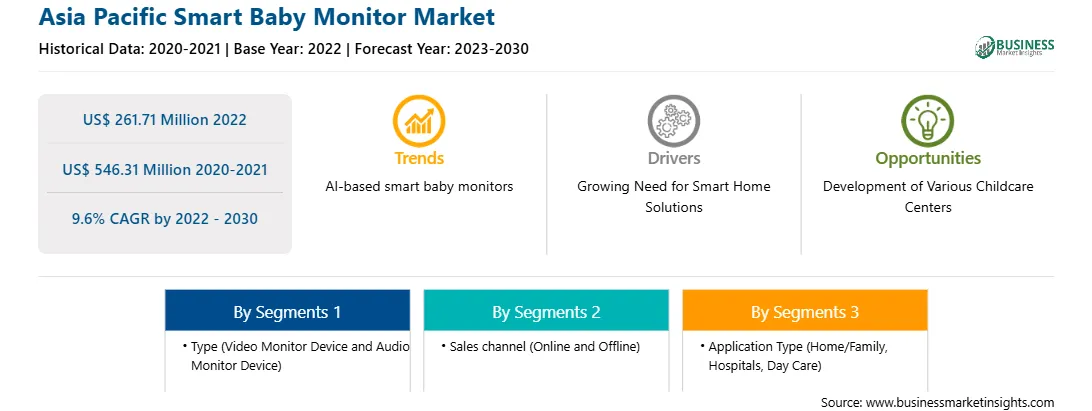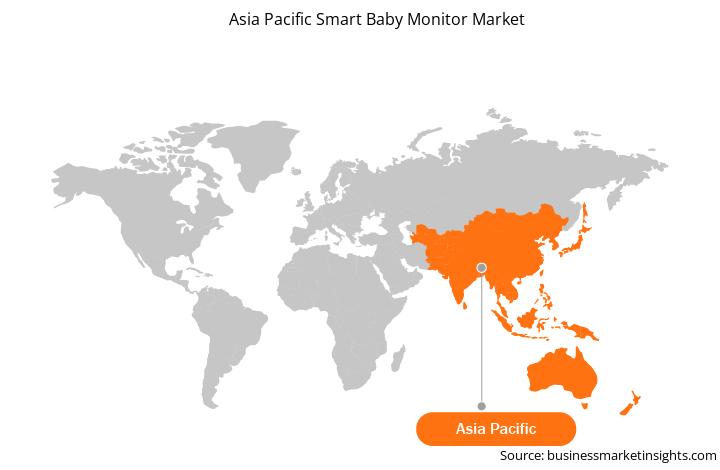The Asia Pacific smart baby monitor market was valued at US$ 261.71 million in 2022 and is expected to reach US$ 546.31 million by 2030; it is estimated to grow at a CAGR of 9.6% from 2022 to 2030.
The smart homes concept is rising continuously across the globe due to a rise in awareness regarding the convenience and enhancements offered by technology to improve day-to-day life. Smart home features such as remote control of home systems, security automation, energy efficiency, and entertainment integration are gaining traction. In addition, the government supports the building of smart homes as it helps to reduce the carbon footprint and optimize energy usage. For instance, the Government of India is focused on enhancing the energy-efficiency levels in residential buildings with future-driven initiatives such as smart home ecosystems, according to the Ministry of Power in July 2021. Thus, the growing awareness of smart homes and rising government support boost the energy-efficient residential sector and foster the integration of advanced technologies in the home. The rising demand for interconnected homes will generate the demand for tech solutions such as smart baby monitors that help parents in real-time monitoring of their baby's condition and health. Therefore, the rise in building smart homes is likely to create growth opportunities for the smart baby monitor market in the coming years.
The smart baby monitor market in APAC is further segmented into China, India, Japan, Australia, South Korea, and the Rest of APAC. China accounts for a considerable share of the overall smart baby monitoring market in APAC. The rise in disposable income and the proliferation of internet infrastructure in Asian countries are the key forces allowing individuals to purchase high-end products, including smartphones, laptops, wearables, and tablets. China, India, Indonesia, and Japan have a large number of smartphone users. Presently, there is a high demand for cost-effective and smart electronic devices such as baby monitoring devices. Policymakers and regulators in both developing and developed countries in APAC are creating a favorable growth and investment environment for the development, adoption, and application of advanced technologies such as artificial intelligence (AI) and the Internet of Things (IoT).
A continuous rise in population and increase in income levels of the middle- and upper-class populations are the significant factors influencing the baby monitor market growth in APAC. The increasing number of working women, mainly in the developing countries in the region, and the mounting potential of smart baby monitor manufacturers indulged in offering a wide variety of products to meet the increasing consumer demands also support the market growth in this region. Adopting baby monitors allows working parents to keep track of their babies and caretakers. The increasing number of nuclear families, working parents, and single parents across the region is compelling manufacturers to develop advanced baby monitoring systems to address parents' concerns regarding baby care and safety during their absence at home.
Moreover, the adoption of these innovative technologies helps them monitor their babies when they are asleep and watch their activities while being involved in other housework. In 2019, Taiwanese tech startup Cubo AI launched an AI-powered baby monitor that is used to differentiate if a baby's face is accidentally covered or intentionally covered. It notifies parents immediately by sending an alert if it is covered accidentally. In addition, in July 2022, Cubo AI launched an AI Sleep Sensor Pad to detect a baby's breathing motion.
Strategic insights for the Asia Pacific Smart Baby Monitor provides data-driven analysis of the industry landscape, including current trends, key players, and regional nuances. These insights offer actionable recommendations, enabling readers to differentiate themselves from competitors by identifying untapped segments or developing unique value propositions. Leveraging data analytics, these insights help industry players anticipate the market shifts, whether investors, manufacturers, or other stakeholders. A future-oriented perspective is essential, helping stakeholders anticipate market shifts and position themselves for long-term success in this dynamic region. Ultimately, effective strategic insights empower readers to make informed decisions that drive profitability and achieve their business objectives within the market.

| Report Attribute | Details |
|---|---|
| Market size in 2022 | US$ 261.71 Million |
| Market Size by 2030 | US$ 546.31 Million |
| Global CAGR (2022 - 2030) | 9.6% |
| Historical Data | 2020-2021 |
| Forecast period | 2023-2030 |
| Segments Covered |
By Type
|
| Regions and Countries Covered | Asia-Pacific
|
| Market leaders and key company profiles |
The geographic scope of the Asia Pacific Smart Baby Monitor refers to the specific areas in which a business operates and competes. Understanding local distinctions, such as diverse consumer preferences (e.g., demand for specific plug types or battery backup durations), varying economic conditions, and regulatory environments, is crucial for tailoring strategies to specific markets. Businesses can expand their reach by identifying underserved areas or adapting their offerings to meet local demands. A clear market focus allows for more effective resource allocation, targeted marketing campaigns, and better positioning against local competitors, ultimately driving growth in those targeted areas.

The Asia Pacific smart baby monitor market is segmented based on type, sales channel, application, and country. Based on type, the Asia Pacific smart baby monitor market is bifurcated into video monitor device and audio monitor device. The video monitor device segment held a larger market share in 2022.
In terms of sales channel, the Asia Pacific smart baby monitor market is bifurcated into online services and offline services. The offline services held a larger market share in 2022.
By application, the Asia Pacific smart baby monitor market is segmented into home/family, hospitals, and day care. The home/family held the largest market share in 2022.
Based on country, the Asia Pacific smart baby monitor market is segmented into Australia, China, India, Japan, South Korea, and the Rest of Asia Pacific. China dominated the Asia Pacific smart baby monitor market share in 2022.
Vtech Holdings Ltd, Koninklijke Philips NV, Samsung Electronics Co Ltd, Panasonic Holdings Corp, Snuza, Dorel Industries Inc, NETGEAR, and Withings are some of the leading companies operating in the Asia Pacific smart baby monitor market.
1. VTech Holdings Ltd
2. Koninklijke Philips NV
3. Samsung Electronics Co Ltd
4. Panasonic Holdings Corp
5. Snuza
6. Dorel Industries Inc
7. NETGEAR
8. Withings.
The Asia Pacific Smart Baby Monitor Market is valued at US$ 261.71 Million in 2022, it is projected to reach US$ 546.31 Million by 2030.
As per our report Asia Pacific Smart Baby Monitor Market, the market size is valued at US$ 261.71 Million in 2022, projecting it to reach US$ 546.31 Million by 2030. This translates to a CAGR of approximately 9.6% during the forecast period.
The Asia Pacific Smart Baby Monitor Market report typically cover these key segments-
The historic period, base year, and forecast period can vary slightly depending on the specific market research report. However, for the Asia Pacific Smart Baby Monitor Market report:
The Asia Pacific Smart Baby Monitor Market is populated by several key players, each contributing to its growth and innovation. Some of the major players include:
The Asia Pacific Smart Baby Monitor Market report is valuable for diverse stakeholders, including:
Essentially, anyone involved in or considering involvement in the Asia Pacific Smart Baby Monitor Market value chain can benefit from the information contained in a comprehensive market report.